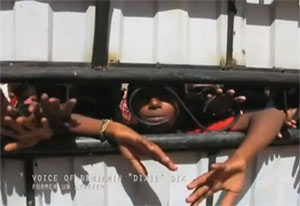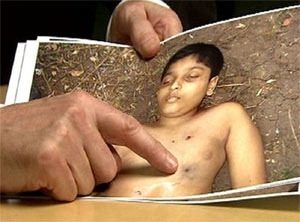Ac. Krtashivananda
Geneva, March 02, 2013
The Sri Lankan military committed numerous war crimes during the final months of the country’s 26-year civil war, according to a documentary aired for the first time, amid vigorous protests from Colombo.
Using graphic video and pictures taken both by retreating Tamil Tiger rebels, civilians and victorious Sri Lankan troops, “No Fire Zone – The Killing Fields of Sri Lanka” presents a chilling picture of the final 138 days of the conflict that ended in May 2009. (Trailer)
Filmmaker Callum Macrae insisted before the screening on Friday that the film at the UN headquarters in Geneva it should be seen as “evidence” of the “war crimes and crimes against humanity” committed by government troops.
“The real truth is coming out,” he said.
Sri Lanka’s ambassador in Geneva, Ravinatha Aryasinha, strongly protested the screening of the film on the sidelines of the ongoing UN Human Rights Council.
Human Rights Watch and Amnesty International, which hosted the screening, are calling for the council to order an international probe.
They charge that Sri Lanka’s domestic Lessons Learnt and Reconciliation Commission (LLRC) has glossed over the military’s role.
The film for instance alleges that a “no fire zone” set up by the government in January, 2009, basically functioned as a trap for the hundreds of thousands of civilians who flooded into it in the hope of finding safety.The area was heavily shelled, and in the film maimed and bloodied bodies, of men, women and children, lay strewn.
The UN has estimated that some 40,000 people were killed in the final months of the war, most of them due to indiscriminate shelling by the Sri Lankan military.
Peter Mackay, a UN worker who was trapped inside the zone for two weeks, questioned in the film why the government would set up the “no fire zone” within range of all of their artillery.
“Either you don’t care if you kill the people in that safe zone or you are actively targeting them,” he said, adding that he believed the latter was true.
He and others describe how aid-centres and makeshift hospitals were shelled soon after UN or Red Cross workers informed the government of their coordinates, which is ironically standard practice to ensure that such places are spared in bombing campaigns.
The footage provided by the retreating Tamil Tigers and civilians is devastating, showing parents wailing over their dying and dead children, but the images provided by the government forces are perhaps even more shocking.
Video of a Tamil commander first being interrogated, and then a picture of his mutilated body in the dirt; naked and bound prisoners coldly executed; dead, naked women, who have clearly been sexually abused filmed amid degrading comments by on looking soldiers.
And then there is footage of the 12-year-old son of Tamil Tiger leader Velupillai Prabhakaran, Balachandran, whose body is seen with five bullet holes in his chest.
He was not caught in cross-fire: a separate video shot two hours earlier, shows him sitting in military custody in a bunker eating a biscuit.
Additional Report
Rape is being used as an instrument of torture by Sri Lankan security forces to extract confessions from suspected Tamil separatist supporters, the rights advocacy group Human Rights Watch has alleged.
As a United Nations Human Rights Council meeting that will examine Sri Lanka’s civil rights record begins in Geneva, a report released by Human Rights Watch, We will teach you a lesson, details 75 statements from Tamil victims who say they were raped and tortured by soldiers police and other pro-government para-military.
Thirty-one of the victims allege they were raped after the cessation of Sri Lanka’s long-running civil war in May 2009.
The last case detailed in the report was in October 2012, but HRW says the practice is continuing and that the 75 cases outlined represent a tiny fraction of the total sexual assaults.
“The Sri Lankan security forces have committed untold numbers of rapes of Tamil men and women in custody,” Brad Adams, Asia director for Human Rights Watch, said. “These are not just wartime atrocities but continue to the present, putting every Tamil man and woman arrested for suspected LTTE involvement at serious risk.”
The Sri Lankan government dismissed the allegations as fake and as Tamil separatist propaganda. Sri Lanka’s military spokesman, Ruwan Wanigasooriya, rejected all of the allegations, saying they lacked credibility. He said the report consisted of ‘‘fabricated allegations’’ and ‘‘good creative writing’’.
The 75 case studies presented by HRW bear strong similarities. All allegations, the rights body says, have been corroborated by medical and legal reports.
Typically, a Tamil man or woman is picked up off the street, or from their home, by a group of men driving an unmarked van.
They are interrogated, tortured – many are beaten with sand-filled pipes or burned with cigarettes – and then raped, usually by several people over several days, until they sign a confession, admitting to activity with separatist terrorist group the Liberation Tigers of Tamil Eelam, the Tamil Tigers. Some people are hung by their arms, others have plastic bags containing petrol forced over their heads.
One man, 21-year-old ‘DK’, alleges he was snatched from the street by two men in a white van in August 2012. He was held in a room and interrogated.
“At night when I was in a small room, a man in civilian clothes came and started touching me indecently. He told me to have oral sex with him. When I refused, he beat me and raped me. This happened every night for four or five nights. I signed the confession when I could not bear this torture any more.”
Opening the Human Rights Council session in Geneva on Monday, the UN’s Human Rights Commissioner Navi Pillay grouped Sri Lanka with countries such as Rwanda, the Palestinian territories, Iraq and Afghanistan as countries where human rights abuses had gone unpunished.
“There are still far too many people with command responsibility who escape justice for serious crimes and gross human rights violations . . . massive violations have occurred in . . . Sri Lanka.
BLACK DAY OF HUMAN RIGHTS
On 21st March 2013, after months of backroom haggling, the US resolution, that has been adopted backed by 25 countries, with 13 opposed and 8 abstentions, is a shameless document that rejected the demand of UNHCR. It “welcomed” the government’s promise to hold provincial elections in the island’s Tamil majority north, and the “progress” in infrastructure rebuilding, de-mining and resettlement. At the same time, it calls on the Rajapakse government “to conduct its own independent and credible investigation into allegations of violations of international human rights law and international humanitarian law.” This is nothing but asking the government to probe its own war crimes. The New York Times described the resolution as “polite diplomatic shorthand for growing evidence that soldiers killed tens of thousands of civilians.”
The LLRC (Lessons Learnt and Reconciliation Commission) was established by Rajapakse during 2010 in a bid to deflect criticism, including from the US, and cover up war crimes. It made limited proposals to disarm paramilitary forces, probe disappearances and extrajudicial killings and forge power-sharing arrangements with the Tamil capitalist elite. Yet, Rajapakse’s government shelved even those proposals.
The US and other global powers backed the war against the LTTE and only voiced human rights criticisms in the final months of the military onslaught. China had emerged as the principal supplier of weapons and financial aid to Rajapakse’s government.
India voted for the resolution, seeking to advance its economic and strategic interests in what it regards as its sphere of influence. The Indian government engaged in behind-the-scene machinations to water down the resolution. For instance, the US draft had called for “unfettered access” for UNHRC officials to visit Sri Lanka. Sri Lankan cabinet minister Keheliya Rambukwella said Colombo was “grateful to India” for removing this and other clauses.
New Delhi wanted these changes to appease the Colombo government, fearing that greater pressure would push Rajapakse further into China’s orbit. New Delhi also calculated that backing demands for UNHRC intervention in Sri Lanka could set a precedent for use against India’s own human right violations.
Political parties in India’s southern Tamil Nadu province had launched a vociferous communal campaign against Colombo, with the Dravida Munnethra Kazagam (DMK) demanding a tough stand on Sri Lanka. The New Delhi government then declared it would move strong amendments to the US draft resolution. Ultimately, however, it moved no amendments and deceived the Tamils. On protest against New Delhi, DMK resigned from the ruling coalition.
Note: Indian Govt. Except issuing some diplomatic jargon, politically compromised and remained a silent spectator in this massacre of Tamilians




